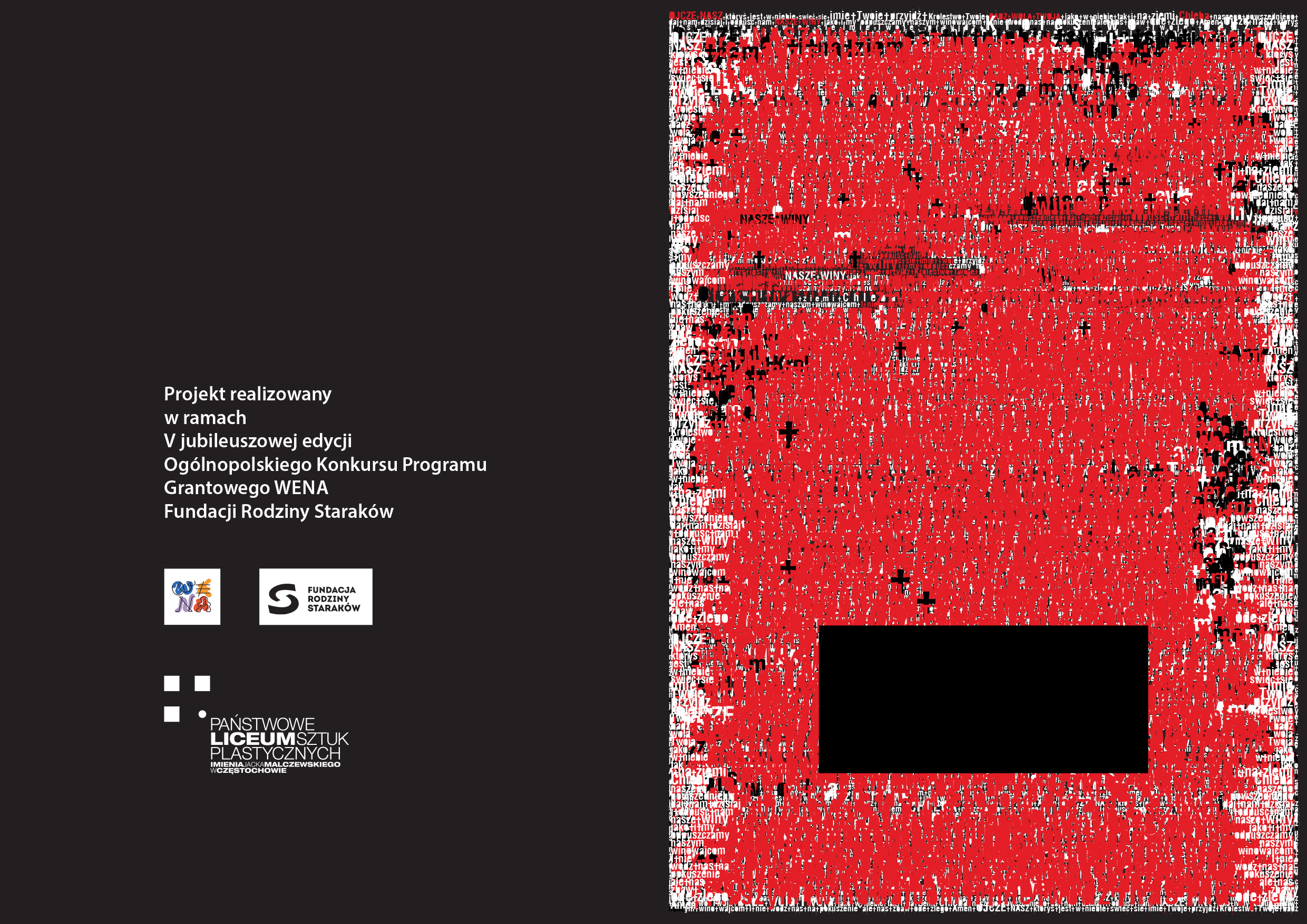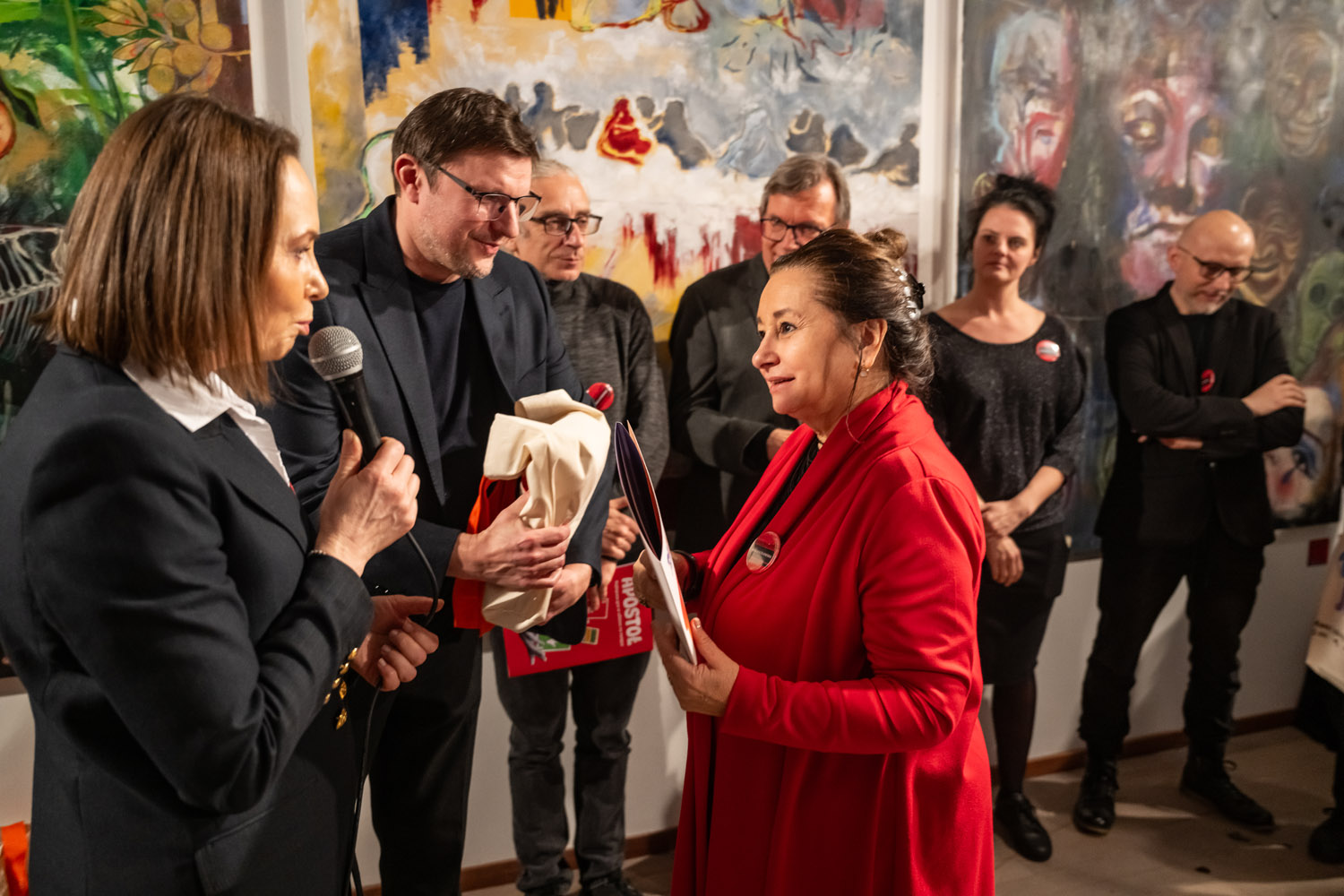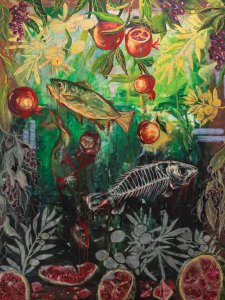A team of students from the State Secondary School of Fine Arts (SSSFA) in Częstochowa – led by Elżbieta Siwik, a seasoned graphic design teacher with long-term experience in projects for young people, whose educational and social preoccupations focus on the relationship between art, people and urban space – has taken up the theme of social performance, describing the surrounding reality to the viewer through the language of art.
The project involves interdisciplinary creative activities by a group of students and educators, inspired by Leonardo da Vinci’s “The Last Supper” and the numerous contemporary artistic interpretations of this masterpiece.
As part of the project implementation and the young people’s mental preparation, the school held open lectures (complementary to the curriculum) on Polish contemporary art of the 1980s and 1990s in the context of social and political changes and burgeoning democracy. This was an opportunity for the participants to deepen their knowledge of contemporary art, based on the artists presenting their works at the Venice Art Biennale. Emphasising the master-disciple relationship, members of the project team analysed Leonardo da Vinci’s “The Last Supper” and its contemporary adaptations within the framework of so-called alternative art.
A lecture on socially engaged contemporary art delivered by Anna Maciejowska, deputy headteacher of the SSSFA in Częstochowa, opened the young people to theoretical considerations and inspired the practical implementation of the performance entitled “The Last Supper”. It is a kind of artistic provocation, making the young artists aware of the importance of socially engaged art. A symbolic return to the roots in the face of predominant electronic communication at a time of changes that are currently unfolding for future generations.
Between September 2023 and January 2024, six meetings took place of the following teachers involved in the project: Elżbieta Siwik (project coordinator, graphic design teacher), Aleksandra Rybak (sculpture teacher), Anna Maciejowska (art historian), Piotr Kaniecki (painting teacher), Łukasz Laskowski (philosophy, classical culture).
This is how the Jacek Malczewski State Secondary School of Fine Arts in Częstochowa commenced and continued the preparation for the huge happening performance. The creative efforts under the project are exteriorised through various visual media, such as installation art, painting, sculpture and photography, while also leveraging the modern digital potential offered by the computer, access to the Internet and AI.
– says Elżbieta Siwik, lead teacher
The lectures began in the second half of December and covered the following topics: Art in the 20th and 21st centuries, from Dadaism to postmodernism; Polish socially engaged art, critical art; The iconography of “The Last Supper”; Biblical descriptions of “The Last Supper”; selected contemporary painters and sculptors, Variations on the theme of “The Last Supper” in contemporary art. Alongside the lectures, the teachers led a discussion panel, bringing students into the debate.
In early March 2024, the scenographic preparation of the venue began - the participants assembled a symbolic Cenacle, placed cameras and the projector, stretched the canvas, arranged the tables and completed the first designs of the Christ figure. At the same time, the students worked on a script for the animated visuals to be displayed against the set decoration. The school’s classrooms were retrofitted with an ultra-short-throw projector, purchased with the project funds.

Transforming the school room into a “Cenacle” to house the “The Last Supper” performance
Behind the table, there will be 12+1 easels, cubbies, screens (whatever the means of artistic expression may be) depending on the means of artistic expression. At this point, the project’s form is open and, as the preparations go on, it will certainly evolve depending on the creators’ individual creativity, sensitivity, knowledge and understanding of the world
– says Elżbieta Siwik
The final exposition featured 12+1 works, placed in the common space of the Cenacle, around a communal table, plus other performative and symbolic activities, carried out with the conviction of a probable (typical of our times) publicist impact. The artistic efforts were broadcast in real time on a big screen in the school’s most accessible place for other students and teachers and streamed on social media.
The idea behind the project’s deliverable was to coalesce space and time into a single event, here and now, in the age of energy crisis, climate crisis, health crisis, in a time of war that shapes global, epochal changes, where the old order is less and less safe for the human population, where the digital revolution is accelerating like never before and leading to who knows where.
At this very moment the younger and older generation of artists come together for “The Last Supper”. The meeting is a manifestation and an answer to the question: “What’s new in art?” Artistic education lacks group creative activities integrated with a common idea in order to build new values. The performative meeting, taking place in real time and streamed live, is a kind of manifestation and an answer to the competition’s question. The project originators closely alluded to the “What’s new” exhibition that had inspired the competition. That 1987 exhibition was a manifesto, a rebellion in the context of the contemporary historical events in Poland and the upcoming socio-political changes.
An interdisciplinary creative effort by a group of students and educators, inspired by Leonardo da Vinci’s “The Last Supper”, taking place in real time and streamed live.
The Last Supper – a pretext for a performance at the School of Fine Arts in Częstochowa

Event folder – front side

Event folder – back side

Event poster
The performance premiere, and thus “The Last Supper” project finale, opened with a speech on the introduction to contemporary art given by Anna Maciejowska, deputy headteacher.
It’s a daring project, which makes us reflect on whether all good things must be bought with suffering. This was the topic of discussion between the young people and their teachers. Redemption through sacrifice, does it always have to be that way? Redemption through tragedy, must it always be so? The answer is all too clear. We are amazed by the intellectual power, creativity and hard work put into the project, as it took several months to implement. The process was documented and recorded. We were afraid of excessive symbolisation, of gaudiness; meanwhile, the maturity of the expression astonished us.
– said Anna Maciejowska

Wieslawa Giedrojć of the Starak Family Foundation, prof. Tomasz Milanowski, Dean of the Faculty of Painting at the Academy of Fine Arts in Warsaw, member of the Jury of the “Wena” Grant Program, Anna Maciejowska, art historian, deputy headteacher of the SSSFA in Częstochowa

The actors served absinthe to the audience
The performance by the school’s students was complemented by an exhibition of artworks thematically linked to the project’s leitmotif. Importantly, in their art, the young people presented an explicit image of the modern, materialised world, which frequently echoes selfishness, hatred, fear and a lack of principles. The sensitive youth from the SSSFA, their teachers and educators set an example that is worth drawing on, as they have shown that the overarching values remain unchanged and that, even today, the most important values are kindness and respect for others.
It took months to create the large-format artistic creations. The work was interspersed with lectures on art history and even on biblical knowledge.





On Maundy Thursday – when thoughts of the Christian world are in the Cenacle – the students, under the guidance of educators, presented large-scale paintings depicting the horror of today’s world: scenes of wartime destruction, strikes and riots. Expressive, impactful. To add to this, there were also video pieces showing, among other things, human cruelty to humans, but also to animals. The visual displays were accompanied by statements in the same vein - imitating the tone of today's media and directly inspired by them, but also incorporating quotations from the Bible.

The performance was embellished by a percussion soundscape created by Andrzej “Harry” Łozowski. This is how the interpretation of The Last Supper A.D. 2024 was structured. It was watched over by a monumental statue of a standing, pensive Christ.

Sculpture of Christ by Aleksandra Rybak

Prof. Tomasz Milanowski, Dean of the Faculty of Painting at the Academy of Fine Arts in Warsaw,
member of the Jury of the "Wena" Grant Program talking to students
Prof. Tomasz Milanowski, Dean of the Faculty of Painting at the Academy of Fine Arts in Warsaw, member of the Jury of the "Wena" Grant Program congratulated students and their masters on the performance. He stated that the project deliverables presented in Częstochowa should be displayed in major galleries. Perhaps in the form of a documentary record that has been created and – for the time being – could be shown in secondary schools in Częstochowa.

Commemorative photograph of the performance participants


Participants in “The Last Supper” project:
students
- Sebastian Baron
- Adam Bednarek
- Maria Filewska
- Kornelia Glin
- Igor Gonera
- Kinga Gruca
- Weronika Gurtman
- Natalia Jacheć
- Katarzyna Karpowicz
- Agnieszka Kołodziejczyk
- Oliwia Komperda
- Marika Kuraś
- Maja Mazur
- Krzysztof Trzepizur
- Tymon Żak
teachers
- Elżbieta Siwik
- Aleksandra Rybak
- Anna Maciejowska
- Piotr Kaniecki
- Łukasz Laskowski
- Maciej Wiłun
- Amelia Szymczyk
Media about the project:
- https://gazetacz.com.pl/mlodziez-plastyka-przedstawia-ostatnia-wieczerza/
- https://gazetaregionalna.com/plastyka/...
LEAD TEACHERS
Elżbieta Siwik – graphic design teacher, has been running Erasmus+ youth projects for many years, organiser of the “Culture doesn’t hurt” social campaign, leader of the project titled “8. Culture doesn't hurt social campaign. Me+You+Us!”, that won an award in the 2nd edition of the “Wena” Grant Program Competition. Her educational and social preoccupations focus on the relationship between art, people and urban space.
Aleksandra Rybak – sculpture and jewellery teacher.
The teachers periodically organise trips to the Venice Biennale of Contemporary Art for school students.












